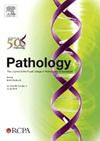SS18-SSX和SSX c端抗体鉴定间充质肿瘤特异性融合癌蛋白。
IF 3
3区 医学
Q1 PATHOLOGY
引用次数: 0
摘要
染色体重排可以通过直接方法或使用融合癌蛋白成分的免疫组织化学作为替代标记来识别。我们的目的是深入了解SS18-SSX和SSX c端抗体在SS18融合肿瘤中的染色情况,并研究它们在滑膜肉瘤谱外含有SSX融合伴侣的软组织肿瘤中的潜在用途。回顾性分析了1999年至2019年在我院诊断的310例软组织肉瘤[通过组织微阵列(TMA)]。作为对照,纳入了14例遗传确认的滑膜肉瘤和1例在2020年至2023年间诊断的EWSR1::SSX2重排肉瘤的全组织切片。使用两种不同的SSX位点抗体:SSX c-terminus和SS18-SSX。310例肉瘤中有21例(6.8%)和25例(8.1%)在TMA上分别显示SS18-SSX和SSX的核染色。在24例滑膜肉瘤中,17例(70.8%)两种抗体均阳性,其中5例SSX核染色较弱。4例(16.7%)仅SS18-SSX阳性,3例(12.5%)仅SSX染色。此外,SSX核表达仅在62例黏液纤维肉瘤中的4例(6.5%)中发现。在对照组中,14例滑膜肉瘤中有11例(78.6%)两种抗体均呈阳性。其余3例SS18-SSX阴性,但至少表现出局部强烈的SSX阳性。EWSR1::SSX2重排肉瘤显示强烈的SSX核阳性。SS18-SSX和SSX c端抗体是可靠的诊断标记,可以用作鉴定特定融合的替代标记。SS18-SSX抗体在滑膜肉瘤中特异性更强,显示出强核染色,而SSX可能呈现弱染色,特异性较低。然而,后者可用于滑膜肉瘤谱外含有SSX融合伴侣的软组织肿瘤。本文章由计算机程序翻译,如有差异,请以英文原文为准。
SS18-SSX and SSX c-terminus antibodies for identification of specific fusion oncoprotein in mesenchymal neoplasms
Chromosomal rearrangement can be identified by direct methods or by using immunohistochemistry for a component of the fusion oncoprotein as a surrogate marker. Our aim was to gain insights into the staining profile using novel SS18-SSX and SSX c-terminus antibodies in SS18 fusion tumours and to investigate their potential use in soft tissue tumours harbouring SSX fusion partner outside the spectrum of synovial sarcoma. A retrospective analysis of 310 soft tissue sarcomas [via tissue microarray (TMA)] diagnosed at our Institution between 1999 and 2019 was performed. As controls, whole tissue sections from 14 genetically confirmed synovial sarcomas and one EWSR1::SSX2 rearranged sarcoma diagnosed between 2020 and 2023 were included. Two different antibodies for SSX locus were used: SSX c-terminus and SS18-SSX. Twenty-one of 310 (6.8%) and 25 of 310 (8.1%) sarcomas on the TMA showed nuclear staining with SS18-SSX and SSX, respectively. From the 24 synovial sarcomas, 17 (70.8%) stained positive for both antibodies, and in five of these cases, nuclear staining for SSX was weak. In four (16.7%) cases, only SS18-SSX was positive, and in three (12.5%) cases, only SSX staining was found. Furthermore, SSX nuclear expression was only found in four of 62 (6.5%) myxofibrosarcomas. In the control cohort, 11 of 14 synovial sarcomas (78.6%) showed positive staining for both antibodies. The remaining three cases were negative for SS18-SSX, but demonstrated at least focally strong positivity for SSX. The EWSR1::SSX2 rearranged sarcoma showed strong nuclear positivity for SSX. SS18-SSX and SSX c-terminus antibodies are reliable diagnostic markers that can be used as a surrogate marker for identification of a specific fusion. The SS18-SSX antibody is more specific and shows strong nuclear staining in synovial sarcomas, whereas SSX can present with weak staining and is less specific. However, the latter can be used in soft tissue tumours harbouring SSX fusion partner outside the spectrum of synovial sarcoma.
求助全文
通过发布文献求助,成功后即可免费获取论文全文。
去求助
来源期刊

Pathology
医学-病理学
CiteScore
6.50
自引率
2.20%
发文量
459
审稿时长
54 days
期刊介绍:
Published by Elsevier from 2016
Pathology is the official journal of the Royal College of Pathologists of Australasia (RCPA). It is committed to publishing peer-reviewed, original articles related to the science of pathology in its broadest sense, including anatomical pathology, chemical pathology and biochemistry, cytopathology, experimental pathology, forensic pathology and morbid anatomy, genetics, haematology, immunology and immunopathology, microbiology and molecular pathology.
 求助内容:
求助内容: 应助结果提醒方式:
应助结果提醒方式:


